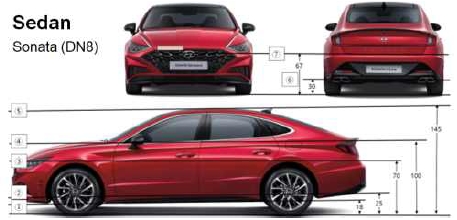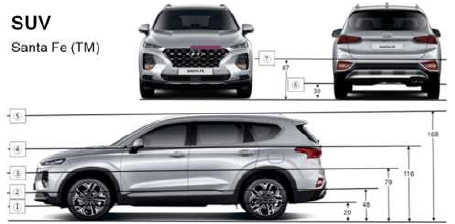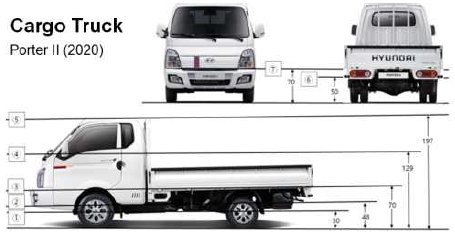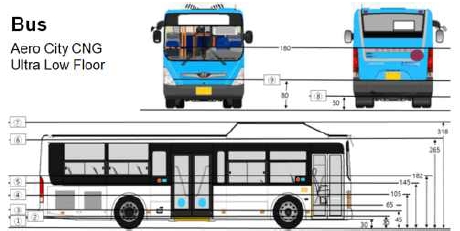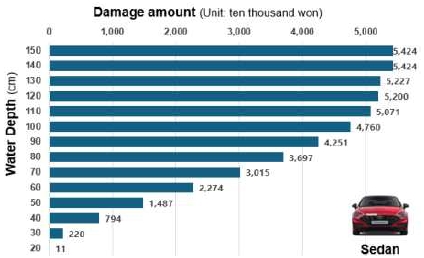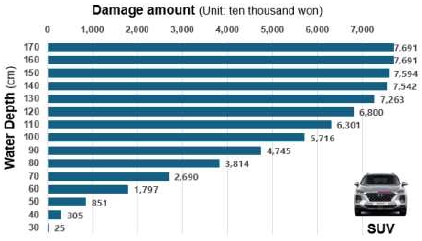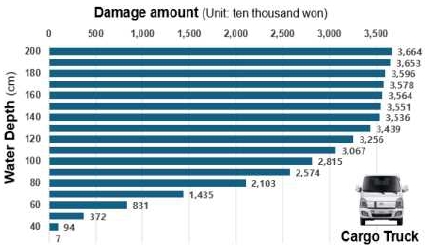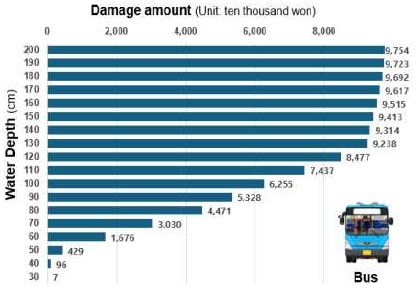
Establishing Flood Risk Criteria for Vehicles based on Flood Damage Assessment
Copyright ⓒ 2024 The Digital Contents Society
This is an Open Access article distributed under the terms of the Creative Commons Attribution Non-CommercialLicense(http://creativecommons.org/licenses/by-nc/3.0/) which permits unrestricted non-commercial use, distribution, and reproduction in any medium, provided the original work is properly cited.

Abstract
Recent recurrent flooding and road flooding, driven by climate change, have been increasing both human casualties and quantitative losses to vehicles. While various studies have been conducted focusing on measures to prevent human casualties, research related to vehicles remains limited. This study aims to assess the economic losses to vehicles based on flood depth and propose flood risk criteria. Four types of vehicles were selected as the study subjects, and flood risk criteria were established using mechanical damage and flood damage costs for different flood depths. The analysis revealed that areas with a flood depth of 20 cm or more should be avoided, or vehicle entry should be restricted, to mitigate vehicle damage from flooding. It is expected that the flood risk criteria based on flood depth proposed in this study will be used in the future to establish vehicle traffic regulations and flood mitigation measures for roadways.
초록
최근 기후변화로 인한 반복적인 홍수와 시가지 내 도로 침수는 차량의 정량적 손실과 인명 피해를 증가시키고 있다. 이에 도로 침수로 인한 차량과 인명 손실 대비를 위한 홍수위험 관련 연구가 다양하게 진행되고 있다. 그러나 주로 인명 피해를 예방하기 위한 홍수위험 및 예방 대책 수립을 중심으로 연구가 이루어졌으며, 차량과 관련된 연구는 미미한 수준이다. 본 연구에서는 침수심에 따른 차량의 경제적 손실을 평가하여 홍수위험 기준을 제시하고자 한다. 이에 대상 차량을 4가지(승용, SUV, 화물트럭, 버스)로 선정하고, 침수심별 기계적 손상과 홍수피해액을 활용하여 침수 위험 기준을 제시하였다. 분석 결과, 침수로부터 차량 피해를 저감하기 위해서는 침수심이 20cm이상인 침수지역은 회피하거나, 차량 진입을 제한할 필요가 있는 것으로 분석되었다. 향후 본 연구의 침수심별 홍수위험 기준을 활용하여 도로 내 차량 통행기준 및 침수대책 수립에 활용되기를 기대한다.
Keywords:
Road Flooding, Flood Risk Level, Crisis Alert Level, Flood Water Depth of Vehicle, Flood Damage키워드:
도로 침수, 침수 위험 수준, 위기 경보 수준, 차량 침수심, 홍수피해액Ⅰ. Introduction
Recently, localized flood damage in Korea has been occurring frequently due to flash floods and heavy rains linked to climate change, resulting in increased financial losses and loss of life [1],[2]. In areas where flooding occurs due to heavy rainfall, if roads that facilitate the movement of people and goods are submerged, it can lead to mechanical damage to vehicles used in economic activities, as well as pose significant risks to the lives of those traveling in those vehicles [3],[4].
To effectively respond to and mitigate flood damage on roads, it is essential to understand the extent of damage to vehicles. Additionally, preparing for such events requires assessing the potential physical damage and recognizing in advance the level of flooding that could harm vehicles.
According to the report on the analysis of traffic accident characteristics during the summer rainy season in [5], an analysis of flooded vehicles in Gangnam-gu, Seoul, from 2006 to 2012 indicated that flooding occurred when rainfall exceeded 35 mm per hour. Furthermore, during rainfall, the slipping accident rates on highways and general roads were 2.44 and 1.43 times higher, respectively, compared to conditions without rainfall. When a vehicle driving on the road becomes submerged due to flooding, mechanical damage may occur depending on the flooding depth and the location of the vehicle's internal components. In Korea, the Ministry of Land, Infrastructure and Transport (2022) categorizes submerged vehicles into internal combustion engine vehicles and electric vehicles [6]. Kim et al. presented the relationship between submergence depth and damage rate by vehicle type as a relative function, incorporating expert opinions [7]. This information was then used to develop a loss model for assessing the impact of water-related disasters.
To reduce damage caused by flooding, it is important to prepare in advance and provide information about potential flooding before it occurs. If this information is not available, it is essential to recognize the risk of flooding and either take a detour or avoid driving on flooded roads. The Ministry of the Interior and Safety of Korea provides guidelines for vehicle users in their Natural Disaster Action Guidelines [8]; however, these guidelines primarily focus on minimizing casualties.
As previously mentioned, while ensuring safety and preventing loss of life are crucial, the value of assets has also been increasing with societal development. In particular, urban areas experience frequent flooding on roadways, which simultaneously affects both vehicles and their occupants. As of 2023, the number of registered vehicles in South Korea stands at approximately 25.95 million, and this number continues to rise. In densely populated urban areas, the concentration of vehicles is also high, leading to an increase in vehicle damage caused by flooding. However, research on flood damage, particularly focusing on vehicle-related losses, remains limited. Therefore, continuous research is needed to develop effective prevention measures and countermeasures for vehicle-related flood damage.
Therefore, in this study, we select representative vehicles to assess the extent of damage caused by road flooding and evaluate the mechanical damage corresponding to flooding depth. Additionally, we aim to determine the risk of vehicle flooding on the road and establish standards for vehicle exposure during such flooding.
Ⅱ. Selection of Representative Vehicles
There are limitations in assessing flooding damage across all vehicles, particularly in identifying specific heights and affected components. Therefore, this study aimed to select representative vehicles based on their physical characteristics. We chose vehicles that are commonly sold and registered in Korea, as well as those that closely resemble the average vehicle in terms of design. As a result, four types of vehicles were selected as representatives: sedans, SUVs(sports utility vehicle), cargo vehicles, and passenger buses.
The heights of various components for each vehicle were selected and categorized as shown in Table 1. Although there may be slight differences in vehicle heights depending on the type, the locations of these components were assumed to be relatively consistent across the vehicles. When flooding occurs on roadways due to a flood, vehicles are affected by the flow velocity and the depth of the water. However, it is difficult to define the relative size and scale of the flow velocity, and there are limitations in determining the vehicle's speed and condition (on/off) based on flooding. Therefore, these factors were excluded from the analysis.
Ⅲ. Calculating Flood Damage by Vehicle Type
3-1 Maintenance Scope of Domestic Flooded Vehicle
The Ministry of Land, Infrastructure and Transport (2022) defines a flooded vehicle as one where the interior floor is submerged [6]. Flooded vehicles are categorized into two types: partial flooding and complete flooding. Insurance and maintenance companies may classify these vehicles as total loss or repairable based on their assessment.
3-2 Quantification of Mechanical Damage Based on Flood Depth by Vehicle Type
Vehicles consist of approximately 20,000 parts. To establish flooding standards for vehicles, the damage amount associated with the depth of flooding was calculated. The unit prices and quantities of each part for the representative vehicles are organized in Table 2, as presented in Table 1. The number of parts was categorized into approximately 150 items based on part type. Upon investigating the prices of each vehicle's parts, it was found that the total cost of the parts exceeded the vehicle's purchase price. Consequently, if the calculated damage amount exceeded the vehicle's purchase price, the purchase price was used as the flood damage amount.
Additionally, when flooding occurs, foreign substances and water infiltrate the vehicle's components, leading to a significant reduction in their performance. Therefore, this study assumes that if the floodwater reaches the vehicle's components, the components will be replaced. The replacement cost of the components was then used to calculate the flood damage costs.
3-3 Calculating Damage Amount by Vehicle Height
Before determining the flood damage amount (repair costs) for a vehicle, it is necessary to estimate the damage to each component based on the flood depth. To do this, the minimum and maximum heights were established according to the location of each part group within the vehicle, categorized by function. The damage amount was estimated by calculating the arithmetic sum of each flood height and the corresponding part items. Notably, labor costs for repairs were excluded, and the damage amount was calculated using only the cost of the parts [9].
Ⅳ. Definition of Flooding Criteria and Risk Levels by Vehicle Type
In this section, the vehicle damage amounts corresponding to flood depth by vehicle type were calculated. The damage amount for each vehicle was determined as the total cumulative cost of the parts based on their locations within the vehicle. Additionally, the extent of damage for each vehicle type was assessed, leading to the definition of flooding criteria and risk levels based on the calculated results.
4-1 Crisis Alert Level
The national crisis warning system is divided into four stages: Blue, Yellow, Orange, and Red, in accordance with the standard manual for disaster crisis management [10]. This structure allows ministries, agencies, and local governments to carry out response activities tailored to each stage. Ultimately, the goal is to foster public understanding and encourage voluntary participation in overcoming dangerous situations [11]. In this paper, the following assumptions were made to define the crisis warning levels related to road flooding:
- - Blue (Attention): Water accumulates in a section of the road.
- - Yellow (Caution): Water reaches below the side steps.
- - Orange (Alert): Water reaches below the side skirt of a car.
- - Red (Severe): Water on the road exceeds 30 cm in depth.
4-2 Analysis of Crisis Alert and Risk Level by Vehicle Type
The side skirt of a sedan vehicle is located approximately 20 cm above the ground. Normally, when water immersion depths are less than 20 cm, the components at the bottom of the vehicle come into contact with water. Since the interior floor height is around 25 cm, prolonged contact with water significantly increases the risk of rust. Additionally, water entering through the vent between the radiator grille and the hood panel at the front of the vehicle can serve as an inlet to the engine cylinder, potentially causing the engine to stall.
In general, it has been analyzed that the damage level of sedan vehicles increases rapidly at low submergence depths due to their low height and the location of most operational components at the bottom. Table 3 outlines the mechanical damage to sedan-type vehicles based on water depth, as well as the qualitative risk levels related to the maintenance scope presented in Table 1. It was found that 80% of the vehicle sustained damage when the submergence depth reached approximately 100 cm, confirming that serious damage occurs with prolonged submersion.
SUV-type vehicles have side skirts positioned about 20 cm above the ground, allowing them to operate even when encountering water due to road flooding below this depth, similar to sedan. However, prolonged contact with water increases the risk of rust. SUVs typically have a higher ground clearance than sedans, with interior flooding occurring at around 45 cm. If water enters the vent connected to the engine at the front, it can cause the engine to stall and result in serious damage to the vehicle.
Additionally, if the flooding depth reaches 66 to 67 cm, approximately the height of the trunk floor, water can infiltrate most major components, leading to significant damage. The mechanical damage and risk levels for SUV-type vehicles evaluated in this study based on flooding depth are presented in Table 4.
Tables 5 and 6 present the results of calculating the degree of mechanical damage and the extent of damage based on the flood water depth of vehicle for cargo trucks and buses, respectively. These tables also define the risk levels associated with water depth for each type of vehicle.
4-3 Generalization of Risk Level According to the Flood Water Depth of Vehicle
In the case of road flooding, the area below the tire centerline of the vehicle is considered normal driving conditions and can typically be managed with simple maintenance and repairs. However, since the drive shaft is connected to the tire centerline, lubricants within the drive shaft may be compromised due to flooding. Additionally, for flooding above the tire centerline, potential damage to affected components must be assessed. Therefore, while qualitative judgments regarding the depth of flooding and potential damage to vehicle parts are necessary, the risk level associated with flooding depth is comprehensively generalized, as shown in Table 7, based on the information presented in Table 1 and Section 4.2.
Ⅴ. Conclusions
There are numerous assessments of human risk in the event of heavy rain or flooding, but establishing quantitative criteria for asset damage, particularly for vehicles, presents challenges. Therefore, this paper proposes flood risk criteria based on mechanical damage to vehicles during road flooding. Specifically, it assesses the vulnerability of damaged assets by evaluating the degree of mechanical damage to vehicles in relation to flooding depth. First, four types of vehicles commonly sold in Korea were selected, and the degree of mechanical damage was estimated by correlating vehicle parts with specific flooding depths. Based on the calculated results for each type, flooding criteria and risk levels were defined for each vehicle type, leading to a comprehensive generalization of risk levels according to the flood water depth of vehicle.
In this study, vehicle flood risk levels were defined as Level 1 (Attention), Level 2 (Caution), Level 3 (Alert), Level 4 (Severe), and Out of Level (Vehicle Stop), with corresponding flood depths of 10 cm, 25 cm, 30 cm, 40 cm, and 60 cm, respectively. The flood depths for each risk level were defined for four representative vehicles. Among them, the sedan, which has the lowest ground clearance, exhibited the lowest flood depths, while the cargo truck and bus showed similar criteria at Level 1 and Level 2, with flood depths of 10 cm and 30 cm, respectively.
The study confirmed that as flood depth increases, vehicle damage rises sharply, but the rate of damage growth decreases beyond a certain height. Based on these findings, it was concluded that it is essential to quickly evacuate or move out of the flooded area when roadways are inundated.
This study aims to demonstrate that by utilizing the vulnerability of damaged assets and assessing the degree of mechanical damage to vehicles, alongside risk criteria for human safety during road flooding, more effective flood risk criteria can be established. It is expected that the results of this study will be utilized in the future to establish traffic restriction criteria for vehicles during roadway flooding caused by floods, as well as to determine the minimum installation standards for road flooding
Acknowledgments
This research was supported by a grant (RS-2022-ND634021(2022-MOIS61-002)) for the Development Risk Prediction Technology of Storm and Flood for Climate Change based on Artificial Intelligence funded by Ministry of Interior and Safety (MOIS, Korea).
References
- G. H. Kim, and H. S. Noh, “Development of Deep Learning Model for Real-Time Flood Detection Using CCTV,” in Proceedings of 2022 DCS Summer Conference, Jeju, pp. 277-278, June-July 2022.
-
Y.-S. Choi, J.-H. Kim, C.-K. Choi, and K.-T. Kim, “Development and Evaluation of a 2-Dimensional Land Surface Flood Analysis Model Using Uniform Square Grid,” Journal of Korea Water Resources Association, Vol. 52, No. 5, pp. 361-372, May 2019.
[https://doi.org/10.3741/JKWRA.2019.52.5.361]

- H. S. Noh, and C. K. Choi, “A Study on the Development of an AI-Based Integrated Road Inundations Management System for Real-Time Prediction, Monitoring and Operation of Road,” in Proceedings of 2022 DCS Summer Conference, Jeju, pp. 180-181, June-July 2022.
-
H.-S. Noh and K.-H. Park, “A Study on Scenario-Based Urban Flood Prediction Using G2D Flood Analysis Model,” Journal of Advanced Navigation Technology, Vol. 27, No. 4, pp. 488-494, August 2023.
[https://doi.org/10.12673/jant.2023.27.4.488]

- Hyundai Marine & Fire Insurance. Report on Analysis of Traffic Accident Characteristics in Summer Rainy Season [Internet]. Available: https://blog.hi.co.kr/2152, .
- Ministry of Land, Infrastructure and Transport, Guidelines for Preventing Illegal Distribution of Flooded Vehicles in Preparation for the Rainy Season, Author, Sejong, August 2022.
-
H.-S. Shim, “Design and Implementation of a Crisis Alert System Based on Disaster and Safety Information,” Journal of Digital Contents Society, Vol. 22, No. 1, pp. 77-84, January 2021.
[https://doi.org/10.9728/dcs.2021.22.1.77]

-
G. Kim, K. Kim, C. Choi, and S. Hong, “Study on Vehicle Loss Evaluation and Vulnerability Function for Flood Loss Assessment Model (1) - Method,” Journal of Climate Research, Vol. 14, No. 4, pp. 267-279, December 2019.
[https://doi.org/10.14383/cri.2019.14.4.267]

- Ministry of the Interior and Safety. Natural Disaster Action Guidelines [Internet]. Available: https://www.safekorea.go.kr/idsiSFK/neo/sfk/cs/contents/prevent/prevent01.html?menuSeq=126, .
- The Board of Audit and Inspection of the Republic of Korea, The Operation of Automobile Insurance and Damage Compensation System, Author, Seoul, Audit Report, June 2021.
-
Y.-H. Hwang, K.-S. We, W.-H. Yi, and W.-J. Yang, “Improvement Directions of the National Crisis Alert System in Korea,” Journal of Korean Society of Disaster & Security, Vol. 9, No. 2, pp. 1-7, December 2016.
[https://doi.org/10.21729/ksds.2016.9.2.1]

저자소개

2017.02:Civil Engineering, Graduate School of Inha University (Ph.D Degree)
2018.10~Present: Research Specialist in Construction Industry Promotion Department, Korea Institute of Civil Engineering and Building Technology (KICT)
※Research Interests:Hydrology, Flood Criteria, Data Mining

2016.08:Civil Engineering, Graduate School of Inha University (Ph.D Degree)
2017.03~2018.10: Postdoctoral researcher in Dept. of Hydro Science and Engineering Research, Korea Institute of Civil Engineering and Building Technology (KICT)
2018.11~Present: Research Specialist in Construction Industry Promotion Department, KICT
※Research Interests:Hydrology, Flood Forecasting, Weather Radar

2015.08:Civil Engineering, Graduate School of Inha University (Ph.D Degree)
2007.10~2008.10: Korea Infrastructure Safety & Technology Corporation (KISTEC)
2015.10~Present: Senior Researcher in Dept. of Hydro Science and Engineering Research, Korea Institute of Civil Engineering and Building Technology (KICT)
2022.08~Present: Senior Researcher in Research Strategic Planning Department, KICT
※Research Interests:Hydrology, Flood Forecasting, Weather Radar, Machine Learning, IoT

2010.08:Department of IT Engineering, Graduate School of Mokwon University (Ph.D Degree)
2012.03~2022.02: Professor in Dept. Computer Engineering, Mokwon University
2022.03~2024.02: Professor in Dept. of Computer Information, Osan University
2023.04~2023.12: Visiting Researcher in Dept. of Hydro Science and Engineering Research, KICT
2024.03~Present: Professor in School of Computing and Artificial Intelligence, Hanshin University
※Research Interests:Computer Vision, Deep Learning, Disaster Prevention Application

